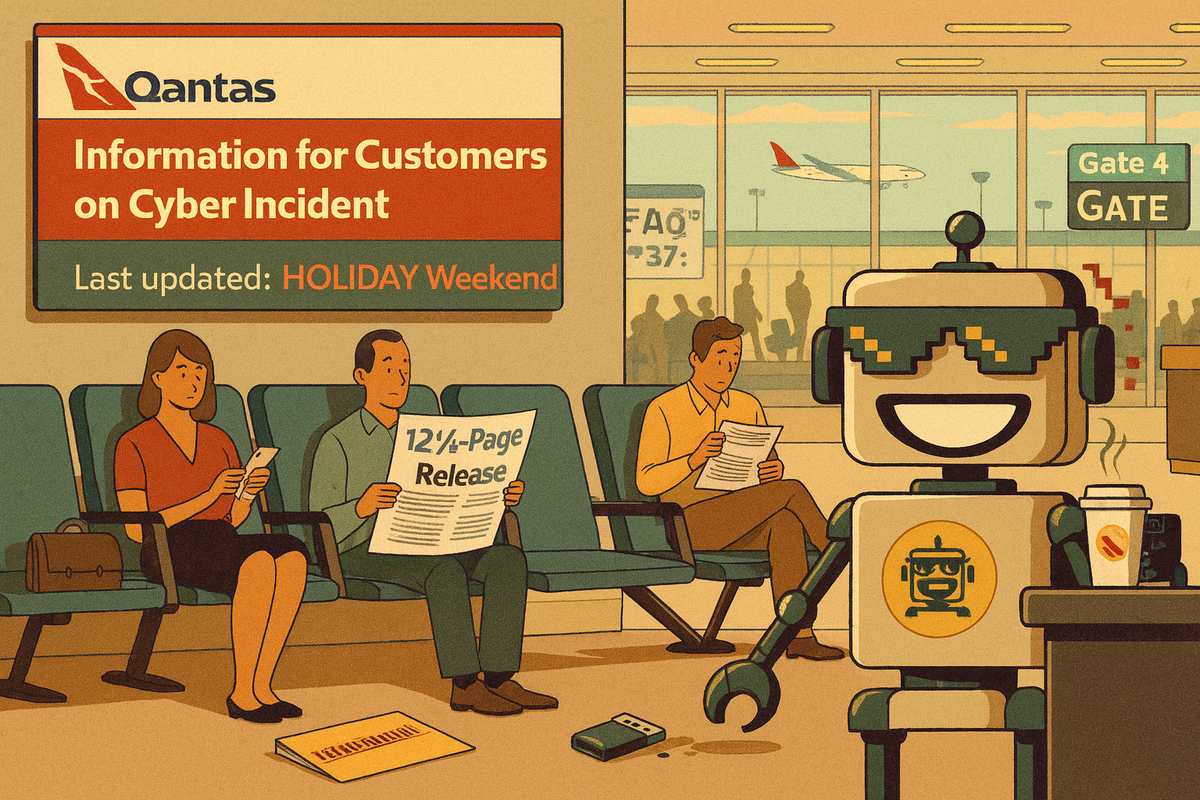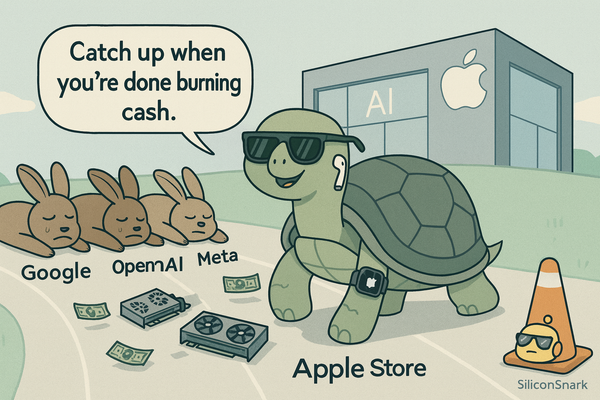Qantas Quietly Drops a Cybersecurity Dumpster Fire on a Weekend
Qantas dropped its cyber breach update on a holiday weekend — and SiliconSnark’s got the snarky breakdown you didn’t know you needed.

Happy weekend, Australia! While you were throwing another shrimp on the barbie or pretending to care about the cricket score, Qantas was busy releasing the corporate equivalent of a smoke alarm test at 3 a.m. on a public holiday: an “update” on its July cyber incident that somehow manages to be both confusing and condescending in equal measure.
Yes, that data breach — the one where customer data was stolen via a “third-party platform” (translation: “not totally our fault, please clap”). Three months later, Qantas has bravely emerged to confirm that, shockingly, the criminals did in fact release some of the stolen data. And the airline’s response? A soothing “we have an injunction,” which is corporate-speak for “we yelled at the internet to stop looking at it.”
The Weekend Data Dump Strategy: Corporate Crisis Management 101
Let’s take a moment to appreciate the timing. The update was published on Saturday, October 12, 2025 — a weekend in Australia. That’s the exact moment when no journalist, regulator, or mildly sentient kangaroo is reading press releases. Coincidence? Of course not. Qantas clearly took a page from the “If we post it late enough, maybe no one will notice” playbook.
You can practically hear the PR team saying, “Perfect, post it now. By Tuesday, everyone’s forgotten — or crashed trying to refresh their flight credits.”
It’s a classic move known as “news burial” — where a company releases bad news during holidays or late Fridays in hopes that your outrage will expire before the next news cycle. In Qantas’ case, it’s less “news burial” and more “bury the entire plane.”
Structurally Unsound: The Press Release That Refuses to End
Let’s talk about the structure. Qantas’ “Information for Customers on Cyber Incident” page reads like a choose-your-own-adventure for corporate damage control.
First, there’s the “Latest Update” (spoiler: the data’s out).
Then, a “Frequently Asked Questions” section that’s basically a polite version of “Please stop calling us.”
Finally, the pièce de résistance: a “Previous Updates” link that no one will ever click unless they’re writing this article.
Every answer is delivered in that soothing, corporate anesthesia tone — the kind that starts with “We take your privacy seriously” and ends with you on hold for 47 minutes. The page even reminds you that “Qantas systems remain secure,” which is exactly what every breached company has said five minutes before finding out… their systems weren’t.
The Legal Shield of Denial
Qantas proudly notes that it obtained an injunction from the NSW Supreme Court “to prevent the stolen data from being accessed, viewed, released, used, transmitted, or published.”
In other words: They sued the hackers to stop being hacked.
That’s like issuing a restraining order against gravity. The legalese is meant to sound proactive, but it mostly reads like, “We’ve done all we can think of that doesn’t involve actually fixing the problem.”
The “It’s Not Just Us” Defense
The airline also assures us it’s “one of a number of companies globally” affected by cyber criminals — the corporate equivalent of pointing at your classmates when the teacher asks who broke the window.
This “we’re not alone” strategy has become a hallmark of modern PR: don’t take responsibility, just form a support group for breached companies and call it resilience.
The FAQ Section: The Gift That Keeps on Gaslighting
The FAQ deserves its own frequent flyer points. Gems include:
- “Check your spam folder.” Because if your data got stolen, surely your biggest concern is finding Qantas’ email about it.
- “Our systems remain secure.” Ah yes, nothing reassures customers like hearing that after their personal info is floating through the dark web.
- “You don’t need to reset your password.” Which is exactly what every cybersecurity expert on Earth tells you not to do after a breach.
- “You may have received multiple emails because we couldn’t match your name.” Translation: our records are a mess.
- “We will never contact you requesting passwords.” Great — now every scammer knows exactly what to pretend not to ask for.
And then there’s the pièce de résistance: “Frequent Flyers can continue to engage with partners as normal.” Wonderful. Even if your address, phone number, and pet’s maiden name got leaked, at least your Qantas Points are safe.
The “Helpful” Hotline Nobody Asked For
Buried deep in the release is a hotline: 1800 971 541. It’s available “24/7,” presumably so you can call at 2 a.m. to hear a tired contractor read the same FAQ you just scrolled past.
If that doesn’t reassure you, Qantas has also “increased training across our teams.” Because nothing stops a hacker like a PowerPoint on phishing awareness.
The PR Playbook, Page by Page
Qantas’ latest cyber incident update checks every box in the Corporate Crisis Template™:
✅ Blame a third party
✅ Claim systems are secure
✅ Name-drop government agencies
✅ Mention “specialist cybersecurity experts”
✅ Offer hotline nobody uses
✅ End with generic safety advice lifted from Cyber.gov.au
It’s almost impressive — a masterclass in the illusion of control. Somewhere in a Sydney boardroom, someone probably got a bonus for this release.
Our Snarky Conclusion (Why It Matters)
At its core, this is about trust — and how tech and travel companies keep asking for it without earning it. Qantas wants you to believe that the sky is safe, the systems are secure, and that “Dear Customer” emails are perfectly normal.
But when you drop a major breach update on a long weekend, in the least searchable format possible, it tells a different story: one where transparency is optional, accountability is delayed, and “proactive communication” means quietly hoping the news cycle forgets you.
The irony? Qantas might have buried this announcement, but thanks to Google indexing (and, let’s be honest, the SEO gods love a scandal), this story will live forever — probably somewhere right next to “Qantas flight delays.”




